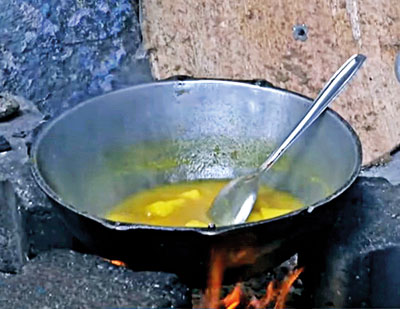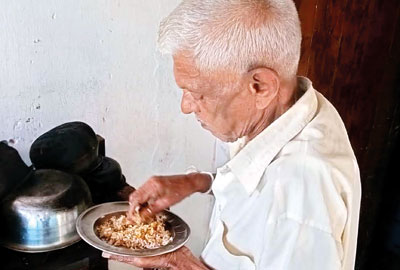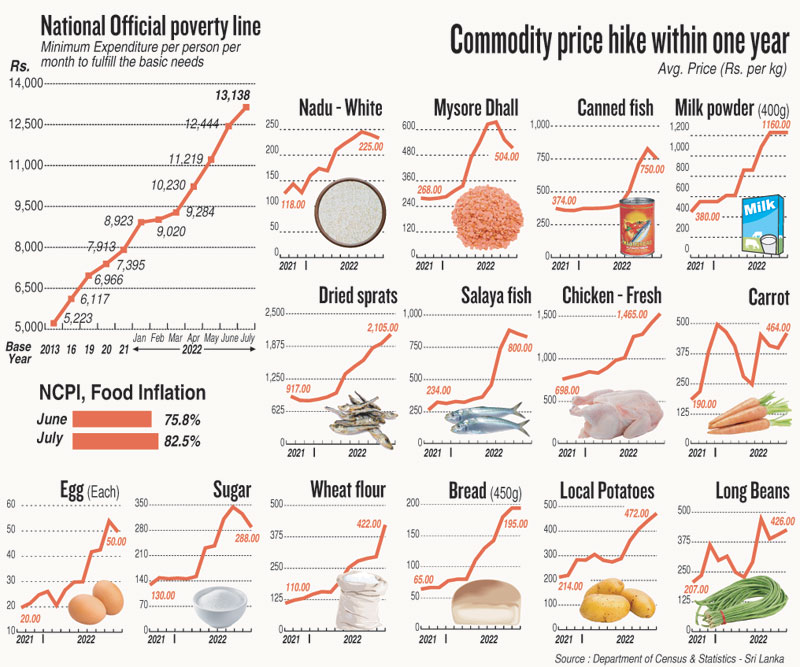News
Families get by without three meals a day
View(s):
Some have cutdown on quantities they cook
By Nadia Fazlulhaq
H. G. Sugathadasa, 79 and his wife Seelawathie, 75, are among the worst affected.
“We have limited our meals to two a day. That, too, is mostly rice and a vegetable dish or a sambol. We cannot even afford dried sprats, or eggs anymore,” said Mr Sugathadasa, a retired driver. The elderly couple, living on the Ella-Passara Road, have a special needs son and two school-going granddaughters.
“Our daughter is doing daily wage jobs to look after us. She keeps telling us to cut costs and the only way is to cut down meals,” a teary-eyed Mrs Seelawathie said.
Sri Lanka’s official poverty line (minimum expenditure to fulfil basic needs) reached Rs.13,138 whereas it was Rs. 7,913 last year, the Census and Statistics Department said.
Food inflation has risen to 82.5%. Compared with last year, prices of all rice varieties have gone up by 100%-125%. Dhal, which was Rs. 265 a kilo, is now sold for between Rs. 464 and Rs 580. Dried sprats were Rs. 933 per kilo last year and now sells for Rs 2,104. The price of wheat flour has risen by 328% from Rs.98 last year to Rs. 422 per kilo. The price of an egg was Rs. 18 last year and Rs 49 now. (See graphic for price comparison of more essential food items).
“My husband is unemployed and we have six mouths to feed. The kerosene price increase, along with price increases of wheat flour, sugar, milk powder, dhal, bread, vegetables, and meat have made it more difficult for us to survive. Our daily meals usually consisted of meat. Skipping meals is common in many households here,” said Hajarah Askar from Mattakkuliya, Colombo 15.
Colombo Municipal Council’s charity commissioner, Surani Sirimanna told the Sunday Timesthat the highest number of urban poor is in north Colombo.

H.G. Sugathadasa: "We have limited our meals to two a day. That, too, is mostly rice and a vegetable dish or a sambol" Pic by Nayananda Buwaneka
“We are sending field officers of the Public Assistance Department to those areas to identify people who need assistance. Selected families are given Rs. 2,000 per month,” she said. The CMC also issued Rs. 3,500 worth one-off dry rations vouchers to 134,000 families in Colombo.
She said charities should organise more community kitchens.
“Many people come to the city for job interviews, hospital clinics, and have no money left to eat,” she said.
The World Food Programme (WFP) office said a recent joint assessment with the UN Food and Agriculture Organization (FAO) found out that nearly 30% of Sri Lankans are food-insecure.
Mr Lakshman, a retail fish vendor, said: “People can’t even afford 250 grams. They buy one small fish for a family. People are now having soya for protein, abandoning dhal, fish, and chicken.’’
Many families can’t afford fresh milk or powdered milk, and they drink tea without milk, or have malted drinks.
“Many children do not have a glass of milk, or milk tea. Some do not have dinner or breakfast. They faint during morning assemblies (at school). It’s sad to see the lunch boxes of children in many schools,” said Joseph Stalin, the president of Ceylon Teachers Union.
Prof. Seetha Priyangani of the Kelaniya University’s department of economics said the food crisis is dragging many low and middle income families to extreme poverty. “The rural poor can be given space for cultivation and continued support with dry rations and proteins at a subsidised rate. But, the urban and estate low-income groups will need food-related support. With global food prices increasing, the food inflation in the country will continue to increase. But, the government should ensure school students and pregnant women get continuous nutrition assistance. The state needs to approach global organisations for this,” she said.
Prof. Priyangani who has researched poverty, said distribution of dry rations, or food supplies should be monitored and even a QR system can be introduced.
President Ranil Wickremesinghe this week said the country needs a national plan to ensure food security and nutrition. A multi-sector combined mechanism needs to be set up.
“A proportion of the people in the country have been deprived of food, while the middle class have lost their income. This situation would not come to an end by December, but could last for two years. Even the fuel price could rise in the winter. Food security should be guaranteed to get rid of this economic crisis and the same food should be produced locally,” he said.
Additional reporting by Nayananda Buwaneka

The best way to say that you found the home of your dreams is by finding it on Hitad.lk. We have listings for apartments for sale or rent in Sri Lanka, no matter what locale you're looking for! Whether you live in Colombo, Galle, Kandy, Matara, Jaffna and more - we've got them all!

